CHRYSLER SEBRING COUPE 2004 2.G Workshop Manual
Manufacturer: CHRYSLER, Model Year: 2004, Model line: SEBRING COUPE, Model: CHRYSLER SEBRING COUPE 2004 2.GPages: 382, PDF Size: 2.23 MB
Page 51 of 382
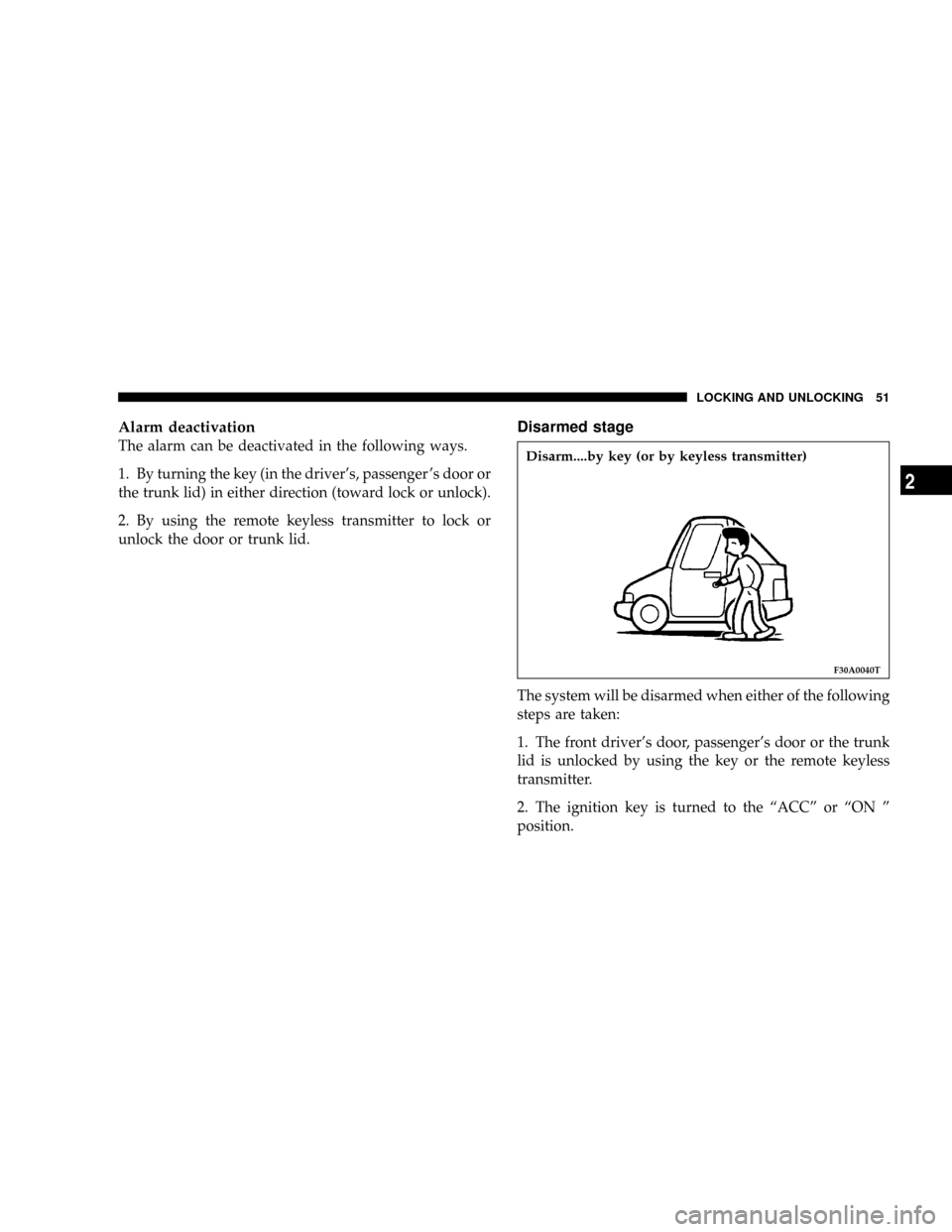
Alarm deactivation
The alarm can be deactivated in the following ways.
1. By turning the key (in the driver's, passenger 's door or
the trunk lid) in either direction (toward lock or unlock).
2. By using the remote keyless transmitter to lock or
unlock the door or trunk lid.
Disarmed stage
The system will be disarmed when either of the following
steps are taken:
1. The front driver's door, passenger's door or the trunk
lid is unlocked by using the key or the remote keyless
transmitter.
2. The ignition key is turned to the ªACCº or ªON º
position.
F30A0040T
Disarm....by key (or by keyless transmitter)
LOCKING AND UNLOCKING 51
2
Page 52 of 382

3. If the UNLOCK switch is pressed when all doors are
closed and no door is opened within approximately 30
seconds, re-arming will automatically occur.
NOTE: Once the system has been disarmed, it cannot be
rearmed except by repeating the arming procedure.
Testing the theft-alarm system
Use the following procedure to test the system:
1. Lower the driver's window.
2. Arm the system as explained in ªArmed stageº.
3. Make sure that the theft-alarm indicator illuminates
and goes off in approximately 20 seconds.
4. Wait a few seconds and then unlock the driver's side
door by using the inside door lock knob and opening the
door.
5. Check to be sure that the horn sounds intermittently
and the headlights blink on and off when the door is
opened.6. Disarm the system by unlocking the front driver's
door, passenger's door or the trunk lid by using the key
or the remote keyless transmitter.
NOTE: To make sure the alarm sounds when the trunk
lid is opened, open the trunk lid by using the trunk lid
release lever.
52 LOCKING AND UNLOCKING
Page 53 of 382

SEATS, SEAT BELTS, CHILD RESTRAINTS AND AIR BAGS
CONTENTS
mFront seats.............................55
NTo adjust seat forward or backward..........57
NTo recline the seatback...................58
NTo adjust seat height (Driver 's side only)......61
NTo adjust lumbar support
(Driver 's side only, if so equipped)..........63
NFor access to the rear seat
(passenger side entry)....................63
mRear seats.............................64
NRear seat capacity......................64
NFold down rear seatbacks.................64
mHead restraints.........................64NAdjustment of the head restraints...........65
mSeat belts..............................66
NUNIBELT restraint system.................67
NUNIBELT instructions....................68
NAdjustable seat belt shoulder anchor
(front seats)...........................71
NEnhanced Driver Seat Belt Use Reminder System
(BeltAlertŸ)..........................72
NSeat belt extender.......................73
mChild restraints.........................74
NInstalling a child restraint system to a UNIBELT
at the rear seat positions or the front passenger
seat (With emergency/automatic locking
mechanism)..........................80
3
Page 54 of 382

NTether anchors for the child restraint system....83
NTether strap anchor installation.............84
NChildren who have outgrown child restraint
systems..............................84
NSeat Belts and Pregnant Women............85mMaintenance and inspection of seat belts......86
mSupplemental Restraint System (SRS) - air bag..87
NSRS servicing..........................98
NTransporting Pets......................100
54 SEATS, SEAT BELTS, CHILD RESTRAINTS AND AIR BAGS
Page 55 of 382
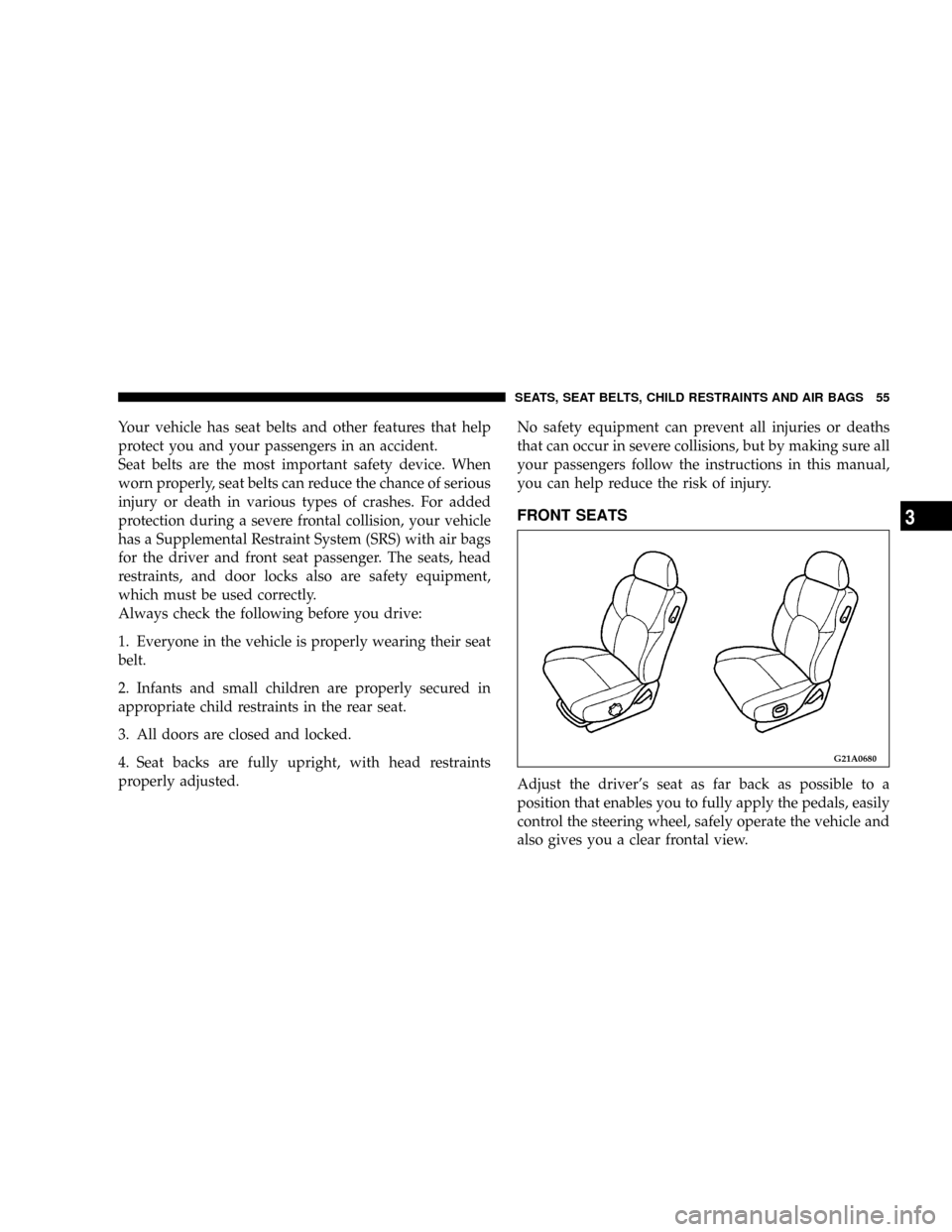
Your vehicle has seat belts and other features that help
protect you and your passengers in an accident.
Seat belts are the most important safety device. When
worn properly, seat belts can reduce the chance of serious
injury or death in various types of crashes. For added
protection during a severe frontal collision, your vehicle
has a Supplemental Restraint System (SRS) with air bags
for the driver and front seat passenger. The seats, head
restraints, and door locks also are safety equipment,
which must be used correctly.
Always check the following before you drive:
1. Everyone in the vehicle is properly wearing their seat
belt.
2. Infants and small children are properly secured in
appropriate child restraints in the rear seat.
3. All doors are closed and locked.
4. Seat backs are fully upright, with head restraints
properly adjusted.No safety equipment can prevent all injuries or deaths
that can occur in severe collisions, but by making sure all
your passengers follow the instructions in this manual,
you can help reduce the risk of injury.
FRONT SEATS
Adjust the driver's seat as far back as possible to a
position that enables you to fully apply the pedals, easily
control the steering wheel, safely operate the vehicle and
also gives you a clear frontal view.
G21A0680
SEATS, SEAT BELTS, CHILD RESTRAINTS AND AIR BAGS 55
3
Page 56 of 382
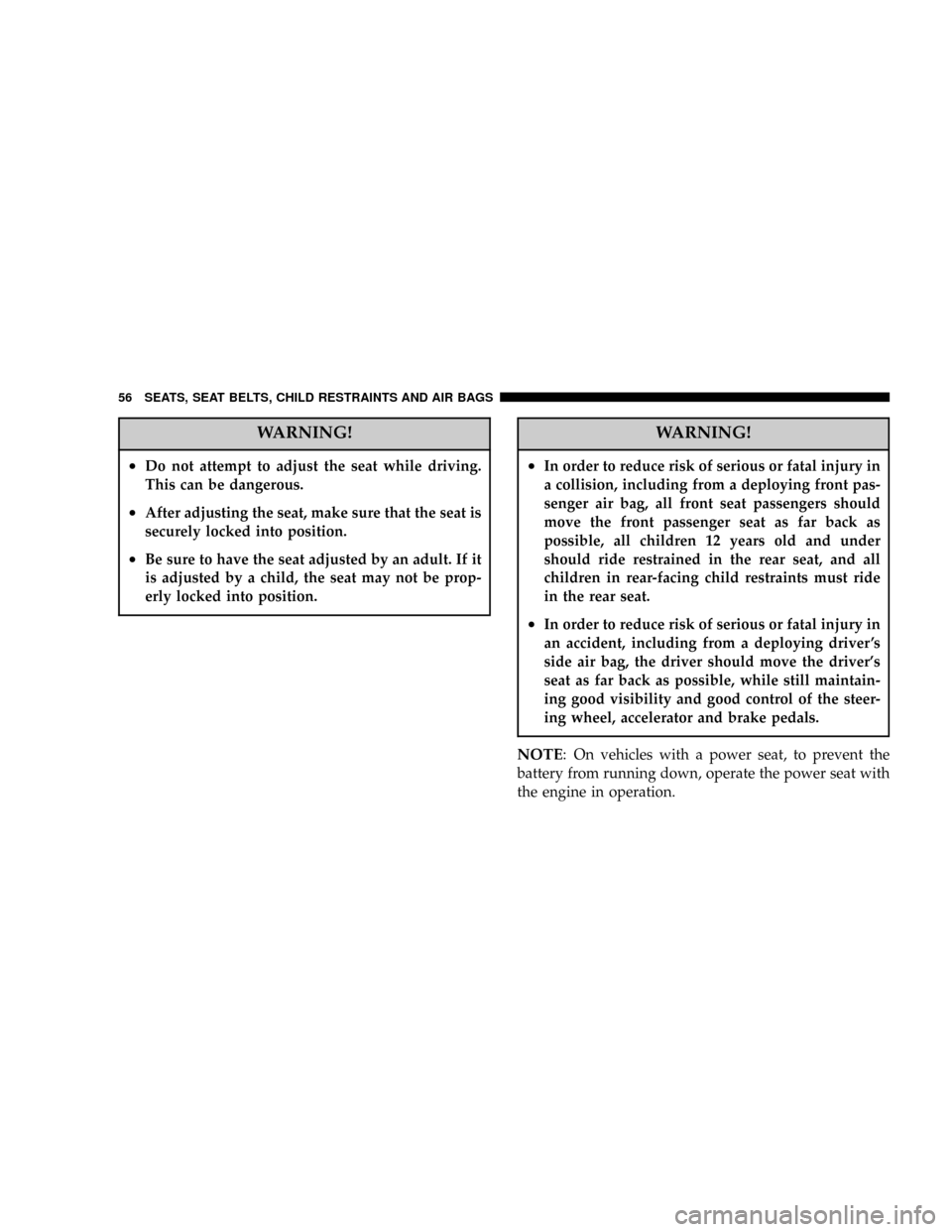
WARNING!
²Do not attempt to adjust the seat while driving.
This can be dangerous.
²After adjusting the seat, make sure that the seat is
securely locked into position.
²Be sure to have the seat adjusted by an adult. If it
is adjusted by a child, the seat may not be prop-
erly locked into position.
WARNING!
²In order to reduce risk of serious or fatal injury in
a collision, including from a deploying front pas-
senger air bag, all front seat passengers should
move the front passenger seat as far back as
possible, all children 12 years old and under
should ride restrained in the rear seat, and all
children in rear-facing child restraints must ride
in the rear seat.
²In order to reduce risk of serious or fatal injury in
an accident, including from a deploying driver 's
side air bag, the driver should move the driver's
seat as far back as possible, while still maintain-
ing good visibility and good control of the steer-
ing wheel, accelerator and brake pedals.
NOTE: On vehicles with a power seat, to prevent the
battery from running down, operate the power seat with
the engine in operation.
56 SEATS, SEAT BELTS, CHILD RESTRAINTS AND AIR BAGS
Page 57 of 382
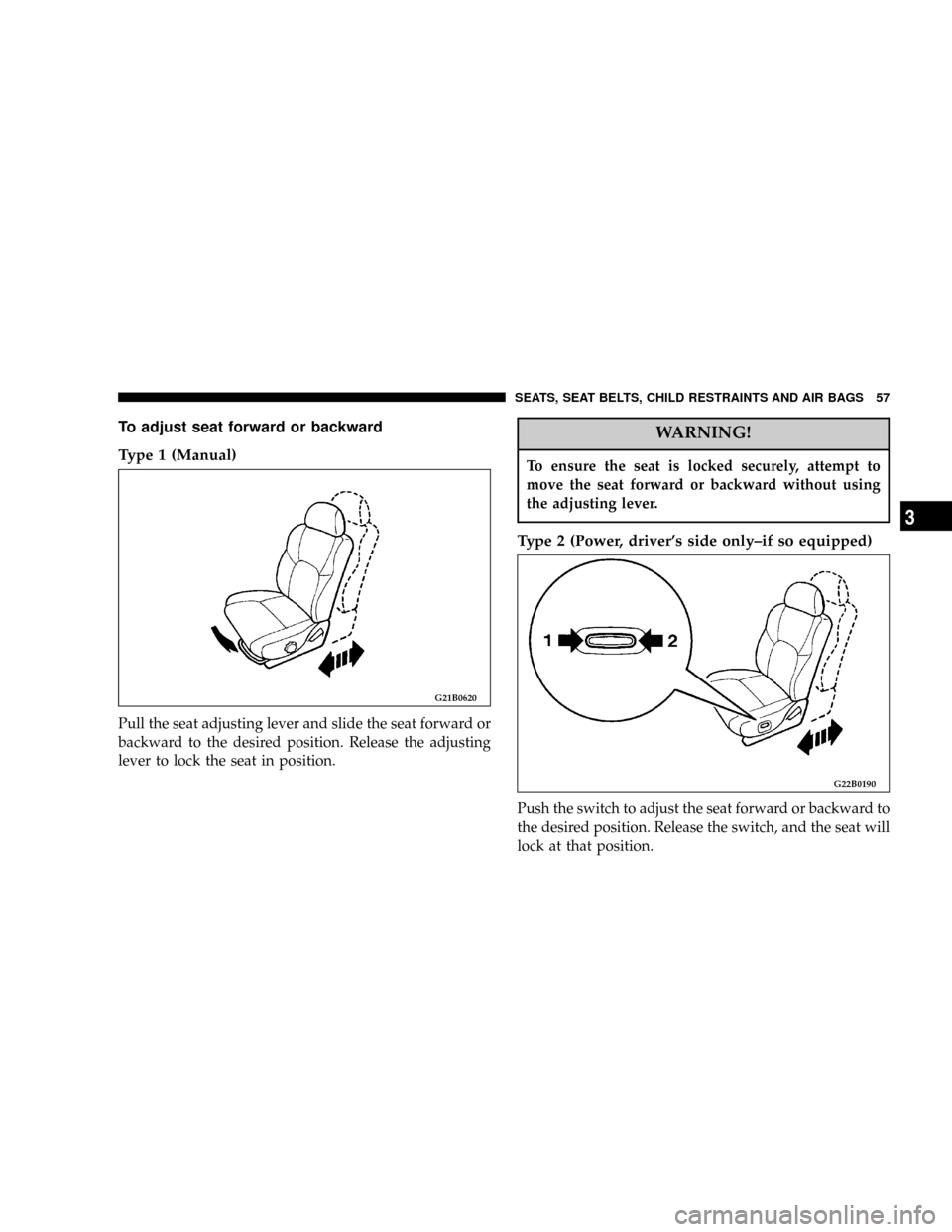
To adjust seat forward or backward
Type 1 (Manual)
Pull the seat adjusting lever and slide the seat forward or
backward to the desired position. Release the adjusting
lever to lock the seat in position.
WARNING!
To ensure the seat is locked securely, attempt to
move the seat forward or backward without using
the adjusting lever.
Type 2 (Power, driver's side only±if so equipped)
Push the switch to adjust the seat forward or backward to
the desired position. Release the switch, and the seat will
lock at that position.
G21B0620
G22B0190
SEATS, SEAT BELTS, CHILD RESTRAINTS AND AIR BAGS 57
3
Page 58 of 382

1. Backward
2. Forward
CAUTION!
Operate the power seat with care not to have the
hand or foot caught by the seat.
To recline the seatback
In order to recline the seatback, first lean your body
forward slightly and pull the seatback lock lever up, and
then lean backward to the desired position and release
the lever. The seatback will lock in that position.
G21C0700
58 SEATS, SEAT BELTS, CHILD RESTRAINTS AND AIR BAGS
Page 59 of 382

Memory reclining knob
When you fold down the seatback by using the memory
reclining knob, the angle of the seatback will be memo-
rized.
Pull the memory reclining knob and fold the seatback
down.Just by pushing the seatback up into position will lock it
in the memorized position.
G21C0870
Memory reclining
knob
G21C0880
SEATS, SEAT BELTS, CHILD RESTRAINTS AND AIR BAGS 59
3
Page 60 of 382
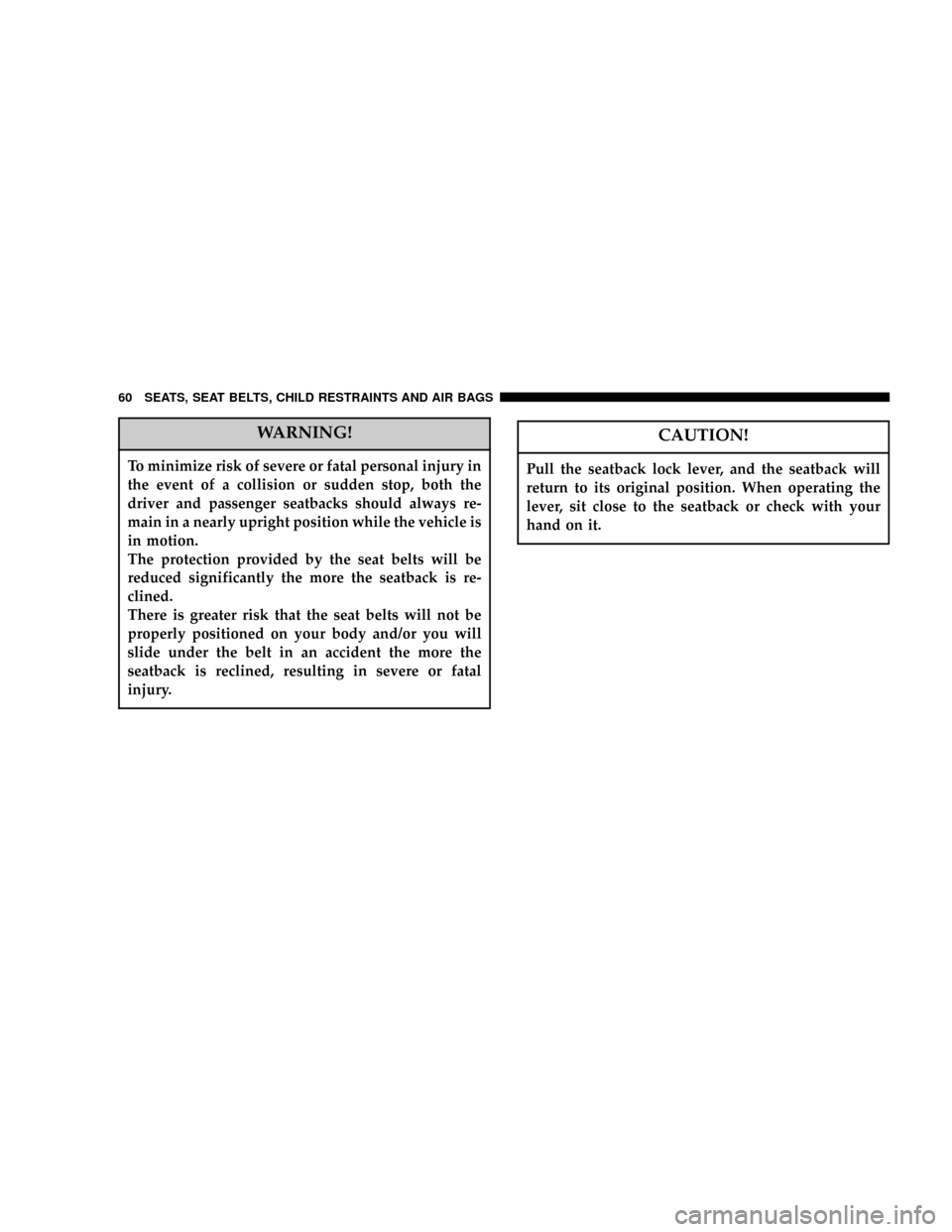
WARNING!
To minimize risk of severe or fatal personal injury in
the event of a collision or sudden stop, both the
driver and passenger seatbacks should always re-
main in a nearly upright position while the vehicle is
in motion.
The protection provided by the seat belts will be
reduced significantly the more the seatback is re-
clined.
There is greater risk that the seat belts will not be
properly positioned on your body and/or you will
slide under the belt in an accident the more the
seatback is reclined, resulting in severe or fatal
injury.
CAUTION!
Pull the seatback lock lever, and the seatback will
return to its original position. When operating the
lever, sit close to the seatback or check with your
hand on it.
60 SEATS, SEAT BELTS, CHILD RESTRAINTS AND AIR BAGS